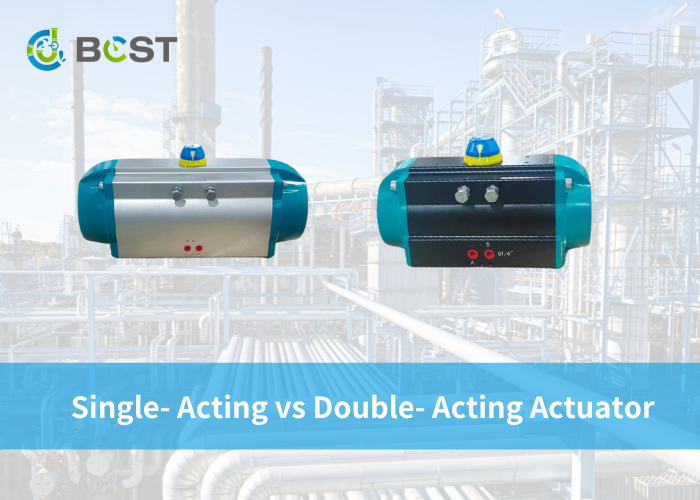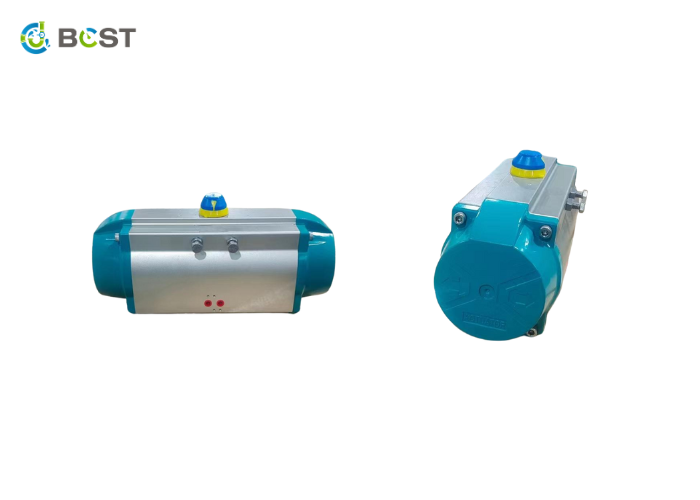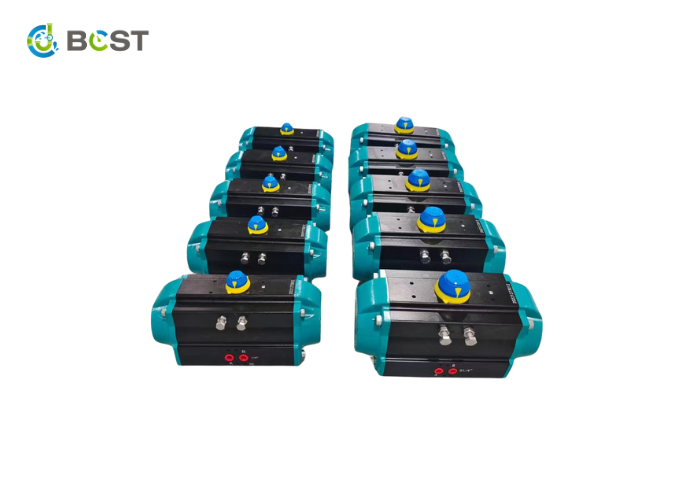
The choice between single-acting and double-acting actuators can be vital in automation and engineering. These devices play a fundamental part in various mechanical systems, and understanding their differences is pivotal to achieving optimal performance and effectiveness. This blog will review the properties, benefits, and uses of single-acting and double-acting actuators to help you make informed judgments about your specific engineering requirements.
Actuators are classified into two types: single-action and double-action.
A single-action control valve is one that’s driven by the air output of the control valve positioner on one side (open or unrestricted) while the other side is moved by a spring or a membrane.
A double action control valve is one that is operated on both sides by the output air of the control valve positioner (sides open and unrestrained).
In typical operations of the ball valve, control valve, and choke valve, two actuators are used: the spring return (or single-acting) actuator and the double-acting actuator.
The spring return actuator is the actuator that uses spring force to place the valve position in the unrestricted or open position. We only need to pressurize on one side to operate the valve.
The double-acting actuator uses a piston as its element to operate the valve. We need to pressurize both sides of the selector alternatively to operate the valve.

When to Use Spring-Return and Double-Acting Actuator?
Torque or Thrust Strength
Generally, the thrust or torque strength of the spring return and double-acting actuator isn’t a concern for coastal oil and gas operations.
Indeed, though some manufacturers generally show that double-acting actuators have more advanced thrust or torque strength than spring return actuators, the difference only exists in veritably high thrust or torque operations, which generally don’t live in coastal applications. As a result, both have the same thrust or torque strength.
Safety Integrated System Application
The spring return is the preferred option in high-security system operations such as shutdown valves (SDV), blow-down valves (BDV), and others that require the valve to be unfettered or open when the signal or supply is gone.
The spring return type is the best choice for safety operations due to its simplicity and trustability. Double-acting actuators are also possible for the fail-close or open application, but the original panel arrangement will be more complex than the spring return type.
Fail in Last Position
When the signal or supply is gone, some processes, such as the product choke valve, require the valve to be in the final position. The choke valve’s default fail position is to fail last in order to maintain the previous output rate.
In the event of a failure, the last position is required, and the best option is a double-acting actuator. The valve is held in place by applying pressure to both sides of the actuator.
Control operation
In the process control operation that uses a control valve as its final control element, the typical actuator is a diaphragm spring return diaphragm for small valves up to 8 inches. When the actuator is 10 inches or greater, it is a double-acting kind to overcome the required high thrust.
The double-acting actuator is also utilized when the action requires a significant amount of push, even if the size is less than 10 inches. This double-acting actuator is stiffer and more stable for control operations, especially in applications where the process condition changes unexpectedly.
When we use the diaphragm spring return type, the thrust on the other side is always the same as the spring. When we use a double-acting actuator, the positioner pressure output manages the other side forces grounded on the factual conditions.

Picking the Appropriate Actuator for Your Operation
When it comes to torque or thrust strength, while some sources suggest that both types of actuators have identical thrust and torque strength capabilities, we recommend taking a close look at your requirements before making a hasty selection. Because of the spring actuator’s design, it’s excellent for circumstances where the torque load is felt on only one side during the activation stroke. In discrepancy, the double-acting actuator works excellently when there are high torque loads in both its working directions and when there’s an increased thrust strength, similar to in numerous oil and natural gas operations.
When demanding safety assurances regarding safety system operations where proximity in shutdowns and fail-strongboxes is of utmost concern, it’s always best to for the most straightforward option. This suggests that the spring return selector should be used because of its ease of design and dependability.
When the valve needs to fail in the last position, there are a variety of applications where it’s necessary to have a valve fall in the former post when it loses its signal or supply. Double-acting actuation works best for these duties because it uses pressurization on both sizes to keep the valve safe and secure in the last position.
Conclusion
The choice between single-acting and double-acting actuators in automation and engineering significantly impacts mechanical system performance. Single-acting actuators are affordable and suitable for one-way duties, whereas double-acting actuators, at a somewhat greater cost, give diversity and precision for bi-directional operations. Choosing the suitable selector depends on specific requirements, budget, and task complexity, eventually affecting performance and cost-effectiveness in automation systems.






